Xin Lin
OmniEduBench: A Comprehensive Chinese Benchmark for Evaluating Large Language Models in Education
Oct 30, 2025Abstract:With the rapid development of large language models (LLMs), various LLM-based works have been widely applied in educational fields. However, most existing LLMs and their benchmarks focus primarily on the knowledge dimension, largely neglecting the evaluation of cultivation capabilities that are essential for real-world educational scenarios. Additionally, current benchmarks are often limited to a single subject or question type, lacking sufficient diversity. This issue is particularly prominent within the Chinese context. To address this gap, we introduce OmniEduBench, a comprehensive Chinese educational benchmark. OmniEduBench consists of 24.602K high-quality question-answer pairs. The data is meticulously divided into two core dimensions: the knowledge dimension and the cultivation dimension, which contain 18.121K and 6.481K entries, respectively. Each dimension is further subdivided into 6 fine-grained categories, covering a total of 61 different subjects (41 in the knowledge and 20 in the cultivation). Furthermore, the dataset features a rich variety of question formats, including 11 common exam question types, providing a solid foundation for comprehensively evaluating LLMs' capabilities in education. Extensive experiments on 11 mainstream open-source and closed-source LLMs reveal a clear performance gap. In the knowledge dimension, only Gemini-2.5 Pro surpassed 60\% accuracy, while in the cultivation dimension, the best-performing model, QWQ, still trailed human intelligence by nearly 30\%. These results highlight the substantial room for improvement and underscore the challenges of applying LLMs in education.
DA$^2$: Depth Anything in Any Direction
Sep 30, 2025Abstract:Panorama has a full FoV (360$^\circ\times$180$^\circ$), offering a more complete visual description than perspective images. Thanks to this characteristic, panoramic depth estimation is gaining increasing traction in 3D vision. However, due to the scarcity of panoramic data, previous methods are often restricted to in-domain settings, leading to poor zero-shot generalization. Furthermore, due to the spherical distortions inherent in panoramas, many approaches rely on perspective splitting (e.g., cubemaps), which leads to suboptimal efficiency. To address these challenges, we propose $\textbf{DA}$$^{\textbf{2}}$: $\textbf{D}$epth $\textbf{A}$nything in $\textbf{A}$ny $\textbf{D}$irection, an accurate, zero-shot generalizable, and fully end-to-end panoramic depth estimator. Specifically, for scaling up panoramic data, we introduce a data curation engine for generating high-quality panoramic depth data from perspective, and create $\sim$543K panoramic RGB-depth pairs, bringing the total to $\sim$607K. To further mitigate the spherical distortions, we present SphereViT, which explicitly leverages spherical coordinates to enforce the spherical geometric consistency in panoramic image features, yielding improved performance. A comprehensive benchmark on multiple datasets clearly demonstrates DA$^{2}$'s SoTA performance, with an average 38% improvement on AbsRel over the strongest zero-shot baseline. Surprisingly, DA$^{2}$ even outperforms prior in-domain methods, highlighting its superior zero-shot generalization. Moreover, as an end-to-end solution, DA$^{2}$ exhibits much higher efficiency over fusion-based approaches. Both the code and the curated panoramic data will be released. Project page: https://depth-any-in-any-dir.github.io/.
CoDoL: Conditional Domain Prompt Learning for Out-of-Distribution Generalization
Sep 18, 2025Abstract:Recent advances in pre-training vision-language models (VLMs), e.g., contrastive language-image pre-training (CLIP) methods, have shown great potential in learning out-of-distribution (OOD) representations. Despite showing competitive performance, the prompt-based CLIP methods still suffer from: i) inaccurate text descriptions, which leads to degraded accuracy and robustness, and poses a challenge for zero-shot CLIP methods. ii) limited vision-language embedding alignment, which significantly affects the generalization performance. To tackle the above issues, this paper proposes a novel Conditional Domain prompt Learning (CoDoL) method, which utilizes readily-available domain information to form prompts and improves the vision-language embedding alignment for improving OOD generalization. To capture both instance-specific and domain-specific information, we further propose a lightweight Domain Meta Network (DMN) to generate input-conditional tokens for images in each domain. Extensive experiments on four OOD benchmarks (PACS, VLCS, OfficeHome and DigitDG) validate the effectiveness of our proposed CoDoL in terms of improving the vision-language embedding alignment as well as the out-of-distribution generalization performance.
LLM-OREF: An Open Relation Extraction Framework Based on Large Language Models
Sep 18, 2025Abstract:The goal of open relation extraction (OpenRE) is to develop an RE model that can generalize to new relations not encountered during training. Existing studies primarily formulate OpenRE as a clustering task. They first cluster all test instances based on the similarity between the instances, and then manually assign a new relation to each cluster. However, their reliance on human annotation limits their practicality. In this paper, we propose an OpenRE framework based on large language models (LLMs), which directly predicts new relations for test instances by leveraging their strong language understanding and generation abilities, without human intervention. Specifically, our framework consists of two core components: (1) a relation discoverer (RD), designed to predict new relations for test instances based on \textit{demonstrations} formed by training instances with known relations; and (2) a relation predictor (RP), used to select the most likely relation for a test instance from $n$ candidate relations, guided by \textit{demonstrations} composed of their instances. To enhance the ability of our framework to predict new relations, we design a self-correcting inference strategy composed of three stages: relation discovery, relation denoising, and relation prediction. In the first stage, we use RD to preliminarily predict new relations for all test instances. Next, we apply RP to select some high-reliability test instances for each new relation from the prediction results of RD through a cross-validation method. During the third stage, we employ RP to re-predict the relations of all test instances based on the demonstrations constructed from these reliable test instances. Extensive experiments on three OpenRE datasets demonstrate the effectiveness of our framework. We release our code at https://github.com/XMUDeepLIT/LLM-OREF.git.
One Flight Over the Gap: A Survey from Perspective to Panoramic Vision
Sep 04, 2025



Abstract:Driven by the demand for spatial intelligence and holistic scene perception, omnidirectional images (ODIs), which provide a complete 360\textdegree{} field of view, are receiving growing attention across diverse applications such as virtual reality, autonomous driving, and embodied robotics. Despite their unique characteristics, ODIs exhibit remarkable differences from perspective images in geometric projection, spatial distribution, and boundary continuity, making it challenging for direct domain adaption from perspective methods. This survey reviews recent panoramic vision techniques with a particular emphasis on the perspective-to-panorama adaptation. We first revisit the panoramic imaging pipeline and projection methods to build the prior knowledge required for analyzing the structural disparities. Then, we summarize three challenges of domain adaptation: severe geometric distortions near the poles, non-uniform sampling in Equirectangular Projection (ERP), and periodic boundary continuity. Building on this, we cover 20+ representative tasks drawn from more than 300 research papers in two dimensions. On one hand, we present a cross-method analysis of representative strategies for addressing panoramic specific challenges across different tasks. On the other hand, we conduct a cross-task comparison and classify panoramic vision into four major categories: visual quality enhancement and assessment, visual understanding, multimodal understanding, and visual generation. In addition, we discuss open challenges and future directions in data, models, and applications that will drive the advancement of panoramic vision research. We hope that our work can provide new insight and forward looking perspectives to advance the development of panoramic vision technologies. Our project page is https://insta360-research-team.github.io/Survey-of-Panorama
NTIRE 2025 Challenge on Day and Night Raindrop Removal for Dual-Focused Images: Methods and Results
Apr 19, 2025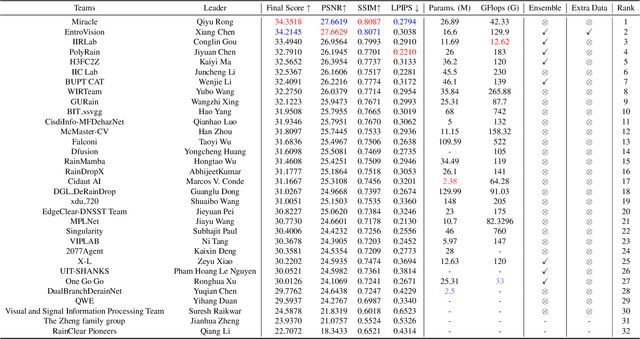
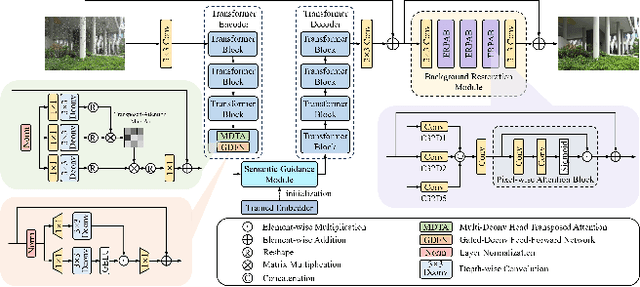
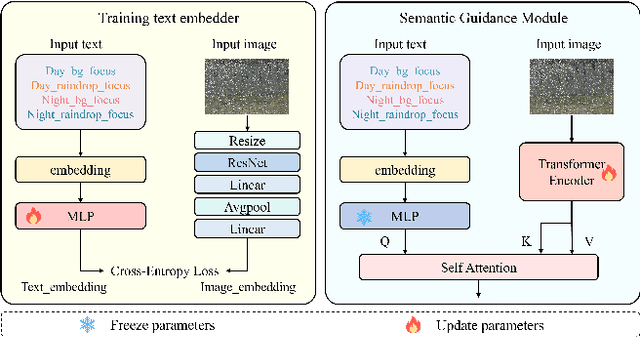
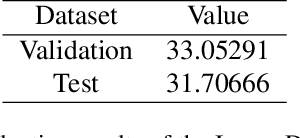
Abstract:This paper reviews the NTIRE 2025 Challenge on Day and Night Raindrop Removal for Dual-Focused Images. This challenge received a wide range of impressive solutions, which are developed and evaluated using our collected real-world Raindrop Clarity dataset. Unlike existing deraining datasets, our Raindrop Clarity dataset is more diverse and challenging in degradation types and contents, which includes day raindrop-focused, day background-focused, night raindrop-focused, and night background-focused degradations. This dataset is divided into three subsets for competition: 14,139 images for training, 240 images for validation, and 731 images for testing. The primary objective of this challenge is to establish a new and powerful benchmark for the task of removing raindrops under varying lighting and focus conditions. There are a total of 361 participants in the competition, and 32 teams submitting valid solutions and fact sheets for the final testing phase. These submissions achieved state-of-the-art (SOTA) performance on the Raindrop Clarity dataset. The project can be found at https://lixinustc.github.io/CVPR-NTIRE2025-RainDrop-Competition.github.io/.
An Empirical Study of GPT-4o Image Generation Capabilities
Apr 08, 2025Abstract:The landscape of image generation has rapidly evolved, from early GAN-based approaches to diffusion models and, most recently, to unified generative architectures that seek to bridge understanding and generation tasks. Recent advances, especially the GPT-4o, have demonstrated the feasibility of high-fidelity multimodal generation, their architectural design remains mysterious and unpublished. This prompts the question of whether image and text generation have already been successfully integrated into a unified framework for those methods. In this work, we conduct an empirical study of GPT-4o's image generation capabilities, benchmarking it against leading open-source and commercial models. Our evaluation covers four main categories, including text-to-image, image-to-image, image-to-3D, and image-to-X generation, with more than 20 tasks. Our analysis highlights the strengths and limitations of GPT-4o under various settings, and situates it within the broader evolution of generative modeling. Through this investigation, we identify promising directions for future unified generative models, emphasizing the role of architectural design and data scaling.
Using Subgraph GNNs for Node Classification:an Overlooked Potential Approach
Mar 09, 2025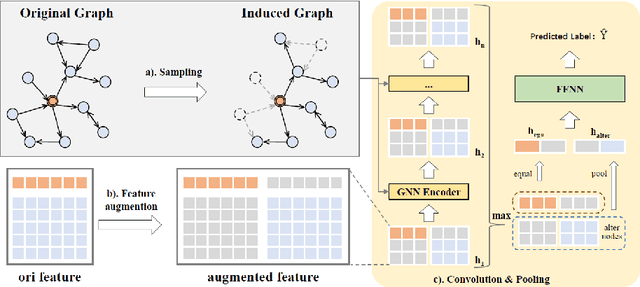
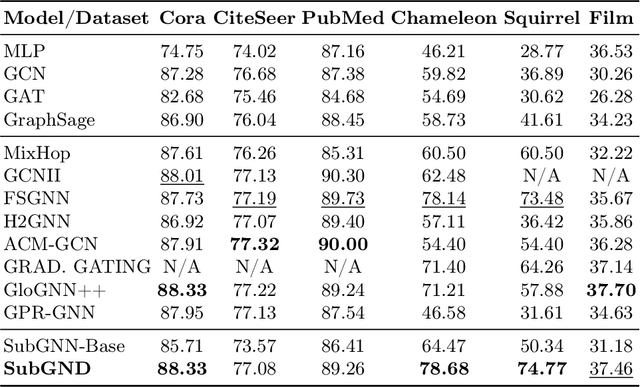
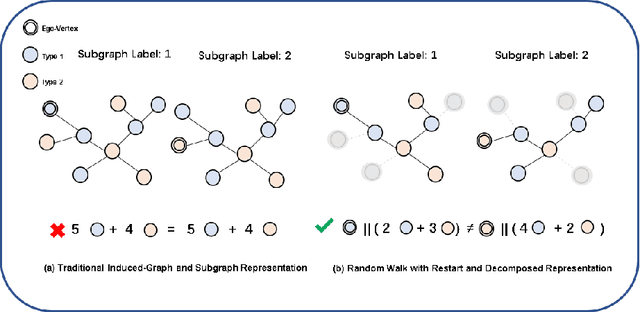

Abstract:Previous studies have demonstrated the strong performance of Graph Neural Networks (GNNs) in node classification. However, most existing GNNs adopt a node-centric perspective and rely on global message passing, leading to high computational and memory costs that hinder scalability. To mitigate these challenges, subgraph-based methods have been introduced, leveraging local subgraphs as approximations of full computational trees. While this approach improves efficiency, it often suffers from performance degradation due to the loss of global contextual information, limiting its effectiveness compared to global GNNs. To address this trade-off between scalability and classification accuracy, we reformulate the node classification task as a subgraph classification problem and propose SubGND (Subgraph GNN for NoDe). This framework introduces a differentiated zero-padding strategy and an Ego-Alter subgraph representation method to resolve label conflicts while incorporating an Adaptive Feature Scaling Mechanism to dynamically adjust feature contributions based on dataset-specific dependencies. Experimental results on six benchmark datasets demonstrate that SubGND achieves performance comparable to or surpassing global message-passing GNNs, particularly in heterophilic settings, highlighting its effectiveness and scalability as a promising solution for node classification.
Every FLOP Counts: Scaling a 300B Mixture-of-Experts LING LLM without Premium GPUs
Mar 07, 2025



Abstract:In this technical report, we tackle the challenges of training large-scale Mixture of Experts (MoE) models, focusing on overcoming cost inefficiency and resource limitations prevalent in such systems. To address these issues, we present two differently sized MoE large language models (LLMs), namely Ling-Lite and Ling-Plus (referred to as "Bailing" in Chinese, spelled B\v{a}il\'ing in Pinyin). Ling-Lite contains 16.8 billion parameters with 2.75 billion activated parameters, while Ling-Plus boasts 290 billion parameters with 28.8 billion activated parameters. Both models exhibit comparable performance to leading industry benchmarks. This report offers actionable insights to improve the efficiency and accessibility of AI development in resource-constrained settings, promoting more scalable and sustainable technologies. Specifically, to reduce training costs for large-scale MoE models, we propose innovative methods for (1) optimization of model architecture and training processes, (2) refinement of training anomaly handling, and (3) enhancement of model evaluation efficiency. Additionally, leveraging high-quality data generated from knowledge graphs, our models demonstrate superior capabilities in tool use compared to other models. Ultimately, our experimental findings demonstrate that a 300B MoE LLM can be effectively trained on lower-performance devices while achieving comparable performance to models of a similar scale, including dense and MoE models. Compared to high-performance devices, utilizing a lower-specification hardware system during the pre-training phase demonstrates significant cost savings, reducing computing costs by approximately 20%. The models can be accessed at https://huggingface.co/inclusionAI.
Easy-Poly: A Easy Polyhedral Framework For 3D Multi-Object Tracking
Feb 26, 2025Abstract:Recent advancements in 3D multi-object tracking (3D MOT) have predominantly relied on tracking-by-detection pipelines. However, these approaches often neglect potential enhancements in 3D detection processes, leading to high false positives (FP), missed detections (FN), and identity switches (IDS), particularly in challenging scenarios such as crowded scenes, small-object configurations, and adverse weather conditions. Furthermore, limitations in data preprocessing, association mechanisms, motion modeling, and life-cycle management hinder overall tracking robustness. To address these issues, we present Easy-Poly, a real-time, filter-based 3D MOT framework for multiple object categories. Our contributions include: (1) An Augmented Proposal Generator utilizing multi-modal data augmentation and refined SpConv operations, significantly improving mAP and NDS on nuScenes; (2) A Dynamic Track-Oriented (DTO) data association algorithm that effectively manages uncertainties and occlusions through optimal assignment and multiple hypothesis handling; (3) A Dynamic Motion Modeling (DMM) incorporating a confidence-weighted Kalman filter and adaptive noise covariances, enhancing MOTA and AMOTA in challenging conditions; and (4) An extended life-cycle management system with adjustive thresholds to reduce ID switches and false terminations. Experimental results show that Easy-Poly outperforms state-of-the-art methods such as Poly-MOT and Fast-Poly, achieving notable gains in mAP (e.g., from 63.30% to 64.96% with LargeKernel3D) and AMOTA (e.g., from 73.1% to 74.5%), while also running in real-time. These findings highlight Easy-Poly's adaptability and robustness in diverse scenarios, making it a compelling choice for autonomous driving and related 3D MOT applications. The source code of this paper will be published upon acceptance.
 Add to Chrome
Add to Chrome Add to Firefox
Add to Firefox Add to Edge
Add to Edge